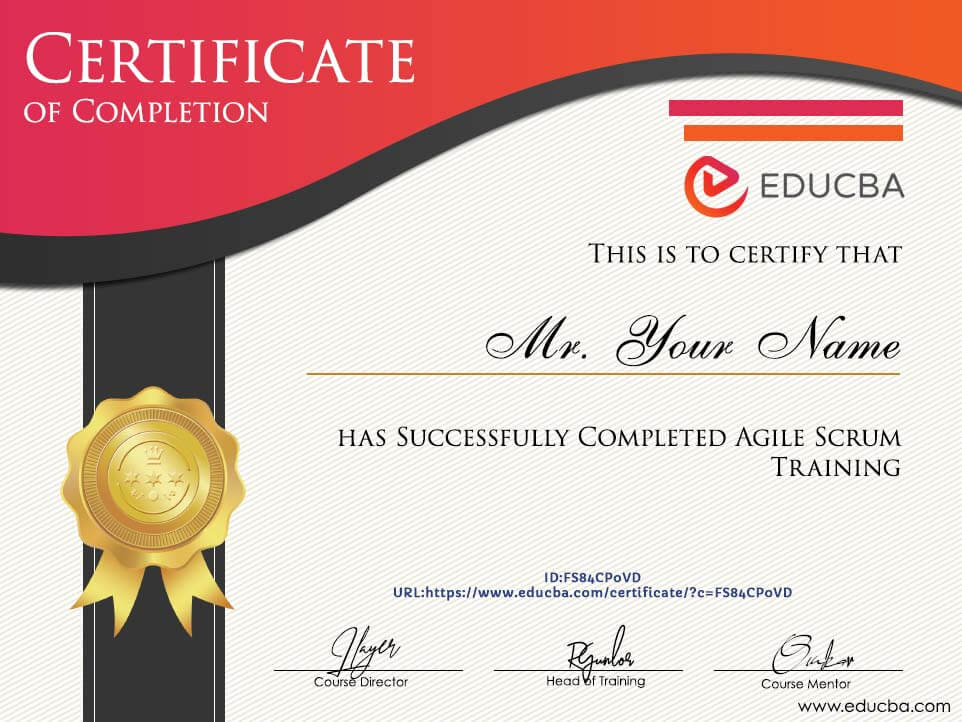Agile and Scrum Mastery: Comprehensive Training Program
Specialization | 8 Course Series | 12 Mock Tests
This Online Agile Scrum Certification includes 9 courses with 44+ hours of video tutorials and One year access and several mock tests for practice. Master Agile and Scrum methodologies with in-depth training. Gain expertise in Certified Scrum Master and Professional Scrum Master. Learn Agile principles, practices, and tools like Pivotal Tracker and Team Foundation Server. Prepare for Agile certifications like PMI-ACP with mock tests and quizzes.
Offer ends in:
What you'll get
- 44+ Hours
- 9 Courses
- Mock Tests
- Course Completion Certificates
- One year access
- Self-paced Courses
- Technical Support
- Mobile App Access
- Case Studies
- Download Curriculum
Synopsis
- Courses: You get access to all 9 courses, Projects bundle. You do not need to purchase each course separately.
- Hours: 44+ Video Hours
- Core Coverage: Learn all important concepts and features in Agile methodologies
- Course Validity: One year access
- Eligibility: Anyone serious about learning Quality Management and wants to make a career in this Field
- Pre-Requisites: Basic knowledge about Project Management would be preferable
- What do you get? Certificate of Completion for each of the 9 courses, Projects
- Certification Type: Course Completion Certificates
- Verifiable Certificates? Yes, you get verifiable certificates for each course with a unique link. These link can be included in your resume/Linkedin profile to showcase your enhanced project management skills
- Type of Training: Video Course – Self-Paced Learning
Content
-
Section 1: Agile and Scrum Fundamentals
Courses No. of Hours Certificates Details Agile and Scrum Overview 1m ✔ Certified Scrum Master - 2024 Training 56m ✔ Professional Scrum Master (PSM I) Training 1h 2m ✔ Scrum Master Training Program 10h 25m ✔ -
Section 2: Agile and Scrum Advanced Training
Courses No. of Hours Certificates Details Agile and Scrum Training - 2024 5h 2m ✔ Agile Professional Certification Preparation (PMI-ACP) 11h 12m ✔ -
Section 3: Agile Project Management Tools
Courses No. of Hours Certificates Details Pivotal Tracker 1h 27m ✔ Team Foundation Server Training 3h 36m ✔ PMI-ACP 11h 46m ✔ -
Section 4: Mock Tests and Quizzes
Courses No. of Hours Certificates Details Test - Agile Certified Practitioner (PMI-ACP) Mock Test Test - Agile Certified Practitioner Mock Test Test - Agile Mini Quiz 1 Test - Agile Mini Quiz 2 Test - Agile Mini Quiz 3 Test - Agile Mini Quiz 4 Test - Agile Mini Quiz 5 Test - Agile Mini Quiz 6 Test - Agile Mini Quiz 7 Test - Agile Mini Quiz 8 Test - Agile Mini Quiz 9 Test - Agile Mini Quiz 10
Description
Welcome to the Agile and Scrum Training Program! This comprehensive course is designed to equip you with the knowledge and skills necessary to excel in Agile project management and Scrum methodologies. Whether you're new to Agile or seeking to enhance your expertise, this program offers a structured learning path covering fundamental concepts, advanced techniques, and practical tools used in Agile project environments. Throughout the course, you'll explore key Agile principles such as iterative development, adaptive planning, and continuous improvement. You'll also delve into the Scrum framework, learning about Scrum roles, ceremonies, and artifacts essential for effective project delivery. Additionally, you'll have the opportunity to gain hands-on experience with popular Agile project management tools, enabling you to streamline collaboration, track progress, and optimize team productivity.
Section 1: Agile and Scrum Fundamentals This section provides a comprehensive overview of Agile and Scrum methodologies, essential for understanding the principles behind iterative development and effective project management. It includes training for becoming a Certified Scrum Master (CSM), covering key concepts, roles, and responsibilities, as well as Professional Scrum Master (PSM I) Training, which delves deeper into Scrum practices and techniques. The Scrum Master Training Program offers an extensive curriculum designed to equip participants with the skills needed to lead Agile teams and facilitate the Scrum process effectively.
Section 2: Agile and Scrum Advanced Training Building upon the fundamentals, this section offers advanced training in Agile and Scrum methodologies. Participants learn how to apply Agile principles in real-world scenarios through Agile and Scrum Training tailored for the year 2024. The Agile Professional Certification Preparation course prepares individuals for certification exams, covering advanced topics such as Agile frameworks, practices, and tools to enhance project delivery and team collaboration.
Section 3: Agile Project Management Tools This section focuses on popular Agile project management tools, including Pivotal Tracker and Team Foundation Server (TFS). Participants learn how to utilize these tools effectively to plan, track, and manage Agile projects, ensuring seamless collaboration and efficient delivery. Additionally, the PMI Agile Certified Practitioner (PMI-ACP) course offers in-depth preparation for the PMI-ACP certification exam, validating expertise in Agile principles and practices.
Section 4: Mock Tests and Quizzes To assess learning outcomes and reinforce understanding, this section provides mock tests and quizzes. Participants can test their knowledge and readiness for Agile and Scrum certification exams, as well as evaluate their proficiency in using Agile project management tools.
By the end of this course, you'll be equipped to lead Agile teams, facilitate Scrum processes, and drive successful project outcomes in dynamic and fast-paced environments. Whether you're aiming to obtain Agile certifications or enhance your project management skills, this program will provide you with the foundation and confidence to excel in Agile and Scrum practices. Let's embark on this journey together and unlock the power of Agile project management!
Sample Certificate

Requirements
- Basic understanding of project management concepts.
- Familiarity with software development processes.
- Prior exposure to Agile methodologies is beneficial but not mandatory.
- Proficiency in using basic computer applications and tools.
- Willingness to engage in hands-on activities and collaborative teamwork.
Target Audience
- Project managers seeking to enhance their knowledge and skills in Agile and Scrum methodologies.
- Software development professionals interested in adopting Agile practices for better project management.
- Individuals aspiring to become certified Scrum Masters or Agile practitioners.
- Teams and organizations transitioning to Agile frameworks looking for comprehensive training and certification preparation.
- Anyone interested in understanding and implementing Agile principles in project management contexts.
Course Ratings

Offer ends in:
Training 5 or more people?
Get your team access to 5,000+ top courses, learning paths, mock tests anytime, anywhere.
Drop an email at: [email protected]

Great value and great class, a must take to advance your career. I found that the class and the format in which is tough are great for self paced learners. One can complete the certification at own pace and replay the parts that are unclear. Great value for the price and will recommend this product to my colleagues.
Omar DeCastro
An adequate introduction to the Pivot Table cloud app, as well as PM tools, lingo and reporting. Additional information includes integration with Jira, Confluence, Bugzilla, time logging systems. Plus API integration. This would be a good starter tool across an agency, but perhaps not at the enterprise level.
Mytch Parks
Details are covered but pace is slow. I had to watch in 1.5x speed. Learnt a lot about using Pivotal tracker. Did not know about this aid before. Now trying to use it in actual agile project applications. Helpful to keep track of Agile activities in an organized way with resource allocation help as well.
Pooja Verma
As an experienced user of using agile approaches I was looking for an addition to the PMP exam to make use of agile project management in complex projects with rapid response times and flexible requirements. The PMI Agile Certified Practitioner course was exactly what I was looking for - handing me practical tools and valuable insights in best practice methods for agile projects management.
Robin Jüllig